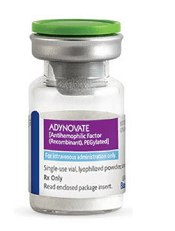
Photo courtesy of Baxalta
The US Food and Drug Administration (FDA) has expanded the approved use of Adynovate, a recombinant pegylated factor VIII (FVIII) product, in patients with hemophilia A.
Adynovate was previously approved as routine prophylaxis and for on-demand treatment of bleeding episodes in patients age 12 and older.
Now, Adynovate is approved for the same indications in patients younger than 12 and for perioperative management in patients of all ages.
Adynovate is built on the full-length Advate molecule, which was approved by the FDA in 2003. Adynovate leverages proprietary pegylation technology designed to extend the amount of FVIII available for use in the body.
The technology was selected because it maintains the integrity of the parent molecule (Advate) while reducing the time at which the body clears Adynovate, resulting in an extended circulating half-life.
Adynovate and Advate are registered trademarks of Baxalta Incorporated, a wholly owned, indirect subsidiary of Shire plc.
For more details on Adynovate, see the full prescribing information.
Trials of Adynovate
The FDA’s approval of Adynovate in children is based on data from a phase 3 trial, which were presented at the World Federation of Hemophilia 2016 World Congress.
The study enrolled previously treated children younger than 12 with no history of FVIII inhibitors. The patients received twice-weekly prophylaxis with Adynovate (50 ± 10 IU/kg) for at least 6 months or 50 exposure days, whichever occurred last.
Sixty-six patients were evaluable. None of them developed inhibitory antibodies, and there were no adverse events related to Adynovate.
The median annualized bleeding rate was 2.0, and 38% of patients did not have any bleeding episodes.
The FDA’s approval of Adynovate for perioperative management was based on interim results of an ongoing phase 3 study in 15 patients with severe hemophilia A undergoing surgical procedures. The interim results were presented at the 2015 ASH Annual Meeting.
The patients underwent 11 major surgical procedures (3 knee replacements, 2 arthroscopic synovectomies, 1 cyst extirpation, 1 port placement, 1 gastric band placement, and 3 multiple tooth extractions including 1 radicular cyst removal) and 4 minor surgeries (1 synoviorthesis, 1 radiosynovectomy, 1 tooth extraction, and 1 dermatological surgery).
Perioperative hemostatic efficacy was rated as “excellent” for most procedures. Excellent hemostatic efficacy was defined as blood loss less than or equal to that expected for the same type of procedure performed in a non-hemophilic patient and requiring blood components for transfusions less than or similar to that expected in the non-hemophilic population.
The median observed intraoperative blood loss (n=10) was 10.0 mL, compared to the predicted average blood loss (n=11) of 50.0 mL for major surgeries.


